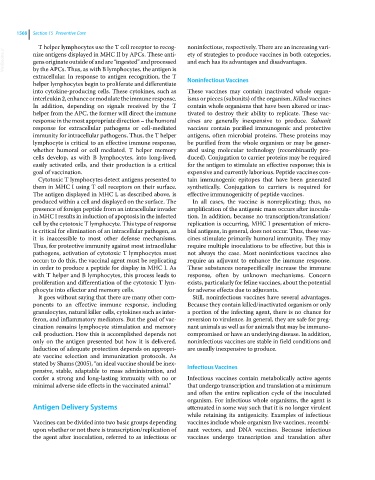Page 1630 - Clinical Small Animal Internal Medicine
P. 1630
1568 Section 15 Preventive Care
T helper lymphocytes use the T cell receptor to recog- noninfectious, respectively. There are an increasing vari-
VetBooks.ir nize antigens displayed in MHC II by APCs. These anti- ety of strategies to produce vaccines in both categories,
and each has its advantages and disadvantages.
gens originate outside of and are “ingested” and processed
by the APCs. Thus, as with B lymphocytes, the antigen is
extracellular. In response to antigen recognition, the T Noninfectious Vaccines
helper lymphocytes begin to proliferate and differentiate
into cytokine‐producing cells. These cytokines, such as These vaccines may contain inactivated whole organ-
interleukin 2, enhance or modulate the immune response. isms or pieces (subunits) of the organism. Killed vaccines
In addition, depending on signals received by the T contain whole organisms that have been altered or inac-
helper from the APC, the former will direct the immune tivated to destroy their ability to replicate. These vac-
response in the most appropriate direction – the humoral cines are generally inexpensive to produce. Subunit
response for extracellular pathogens or cell‐mediated vaccines contain purified immunogenic and protective
immunity for intracellular pathogens. Thus, the T helper antigens, often microbial proteins. These proteins may
lymphocyte is critical to an effective immune response, be purified from the whole organism or may be gener-
whether humoral or cell mediated. T helper memory ated using molecular technology (recombinantly pro-
cells develop, as with B lymphocytes, into long‐lived, duced). Conjugation to carrier proteins may be required
easily activated cells, and their production is a critical for the antigen to stimulate an effective response; this is
goal of vaccination. expensive and currently laborious. Peptide vaccines con-
Cytotoxic T lymphocytes detect antigens presented to tain immunogenic epitopes that have been generated
them in MHC I using T cell receptors on their surface. synthetically. Conjugation to carriers is required for
The antigen displayed in MHC I, as described above, is effective immunogenicity of peptide vaccines.
produced within a cell and displayed on the surface. The In all cases, the vaccine is nonreplicating; thus, no
presence of foreign peptide from an intracellular invader amplification of the antigenic mass occurs after inocula-
in MHC I results in induction of apoptosis in the infected tion. In addition, because no transcription/translation/
cell by the cytotoxic T lymphocyte. This type of response replication is occurring, MHC I presentation of micro-
is critical for elimination of an intracellular pathogen, as bial antigens, in general, does not occur. Thus, these vac-
it is inaccessible to most other defense mechanisms. cines stimulate primarily humoral immunity. They may
Thus, for protective immunity against most intracellular require multiple inoculations to be effective, but this is
pathogens, activation of cytotoxic T lymphocytes must not always the case. Most noninfectious vaccines also
occur; to do this, the vaccinal agent must be replicating require an adjuvant to enhance the immune response.
in order to produce a peptide for display in MHC I. As These substances nonspecifically increase the immune
with T helper and B lymphocytes, this process leads to response, often by unknown mechanisms. Concern
proliferation and differentiation of the cytotoxic T lym- exists, particularly for feline vaccines, about the potential
phocyte into effector and memory cells. for adverse effects due to adjuvants.
It goes without saying that there are many other com- Still, noninfectious vaccines have several advantages.
ponents to an effective immune response, including Because they contain killed/inactivated organism or only
granulocytes, natural killer cells, cytokines such as inter- a portion of the infecting agent, there is no chance for
feron, and inflammatory mediators. But the goal of vac- reversion to virulence. In general, they are safe for preg-
cination remains lymphocyte stimulation and memory nant animals as well as for animals that may be immuno-
cell production. How this is accomplished depends not compromised or have an underlying disease. In addition,
only on the antigen presented but how it is delivered. noninfectious vaccines are stable in field conditions and
Induction of adequate protection depends on appropri- are usually inexpensive to produce.
ate vaccine selection and immunization protocols. As
stated by Shams (2005), “an ideal vaccine should be inex- Infectious Vaccines
pensive, stable, adaptable to mass administration, and
confer a strong and long‐lasting immunity with no or Infectious vaccines contain metabolically active agents
minimal adverse side effects in the vaccinated animal.” that undergo transcription and translation at a minimum
and often the entire replication cycle of the inoculated
organism. For infectious whole organisms, the agent is
Antigen Delivery Systems attenuated in some way such that it is no longer virulent
while retaining its antigenicity. Examples of infectious
Vaccines can be divided into two basic groups depending vaccines include whole organism live vaccines, recombi-
upon whether or not there is transcription/replication of nant vectors, and DNA vaccines. Because infectious
the agent after inoculation, referred to as infectious or vaccines undergo transcription and translation after

